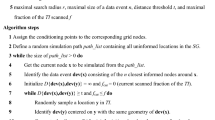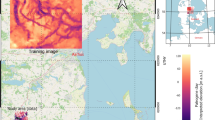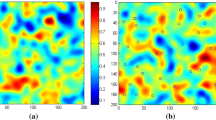Abstract
Multiple-point geostatistical (MPS) simulation can enhance extraction and synthesis of various information in earth and environmental sciences. In particular, it is able to characterize the complex spatial structures of heterogeneous phenomena more accurately. In this paper, we propose a new MPS simulation method based on conditional conduction probability, namely the CCPSIM algorithm, to mitigate the uncertainty of MPS realizations. In CCPSIM, the simulated nodes will be treated differently from the original samples. The probability distributions of the simulated nodes will be used as prior conditions to calculate the probability distributions of the following nodes, and the prior conditions will be conducted during the whole simulation process. 2D and 3D synthetic tests are used to verify the applicability and advantages of CCPSIM. The results confirm that CCPSIM is able to reproduce spatial patterns of heterogeneous structures presented in categorical training images, and it reduces the uncertainty of the MPS realizations caused by the undistinguished using of the original known samples and the simulated uncertain values.
















Similar content being viewed by others
References
Abdollahifard MJ, Baharvand M, Mariéthoz G (2019) Efficient training image selection for multiple-point geostatistics via analysis of contours. Comput Geosci 128:41–50
Arpat GB, Caers J (2007) Conditional simulation with patterns. Math Geol 39(2):177–203
Azamifard A, Rashidi F, Pourfard M, Ahmadi M, Dabir B (2020) Enduring effect of permeability texture for enhancing accuracy and reducing uncertainty of reservoir fluid flow through porous media. Petr Sci 17(1):118–135
Baninajar E, Sharghi Y, Mariethoz G (2019) MPS-APO: a rapid and automatic parameter optimizer for multiple-point geostatistics. Stoch Environ Res Risk Assess 33(11–12):1969–1989
Caers J (2001) Geostatistical reservoir modelling using statistical pattern recognition. J Petr Sci Eng 29(3–4):177–188
Cao Z, Li L, Chen K (2018) Bridging iterative ensemble smoother and multiple-point geostatistics for better flow and transport modeling. J Hydro 565:411–421
Chen Q, Liu G, Ma X, Zhang J, Zhang X (2019) Conditional multiple-point geostatistical simulation for unevenly distributed sample data. Stoch Environ Res Risk Assess 33(4–6):973–987
Chen Q, Liu G, Ma X, Li X, He Z (2020) 3D stochastic modeling framework for quaternary sediments using multiple-point statistics: a case study in minjiang estuary area, southeast China. Comput Geosci 136:104404
Chen Q, Mariethoz G, Liu G, Comunian A, Ma X (2018) Locality-based 3-D multiple-point statistics reconstruction using 2-D geological cross sections. Hydrol Earth Syst Sci 22:6547–6566
Comunian A, Giudici M (2016) Hybrid inversion method to estimate hydraulic transmissivity by combining multiple-point statistics and a direct inversion method. Math Geosci 50(2):147–167
Comunian A, Renard P, Straubhaar J (2012) 3D multiple-point statistics simulation using 2D training images. Comput Geosci 40(3):49–65
Eskandari K, Srinivasan S (2007) Growthsim–a multiple point framework for pattern simulation. In: EAGE Conference on Petroleum Geostatistics
Feng W, Wu S, Yin Y, Zhang J, Zhang K (2017) A training image evaluation and selection method based on minimum data event distance for multiple-point geostatistics. Comput Geosci 104(7):35–53
Feng W, Yin Y, Zhang C, Duan T, Zhang W, Hou G, Zhao L (2019) A training image optimal selecting method based on composite correlation coefficient ranking for multiple-point geostatistics. J Petr Sci Eng 179:292–311
Guardiano FB, Srivastava RM (1993) Multivariate geostatistics: beyond bivariate moments. Geostatistics troia’92. Springer, Netherlands, pp 133–144
Gueting N, Caers J, Comunian A, Vanderborght J, Englert A (2018) Reconstruction of three-dimensional aquifer heterogeneity from two-dimensional geophysical data. Math Geosci 50(1):53–75
Hansena TM, Vub LT, Bachb T (2016) MPSLIB: a C++ class for sequential simulation of multiple-point statistical models. SoftwareX 5:127–133
Hermans T, Nguyen F, Caers J (2015) Uncertainty in training image-based inversion of hydraulic head data constrained to ERT data: workflow and case study. Water Resour Res 51(7):5332–5352
Hoffimann J, Scheidt C, Barfod A, Caers J (2017) Stochastic simulation by image quilting of process-based geological models. Comput Geosci 106:18–32
Li Y, He X, Teng Q, Feng J, Wu X (2018) Markov prior-based block-matching algorithm for superdimension reconstruction of porous media. Am Phys Soc 97(4):043306
Li L, Srinivasan S, Zhou H, Gomez-Hernandez JJ (2015) Two-point or multiple-point statistics? A comparison between the ensemble Kalman filtering and the ensemble pattern matching inverse methods. Adv Water Resour 86:297–310
Linde N, Renard P, Mukerji T, Caers J (2015) Geological realism in hydrogeological and geophysical inverse modeling: a review. Adv Water Resour 86:86–101
Mahmud K, Mariethoz G, Baker A, Treble PC (2018) Hydrological characterization of cave drip waters in a porous limestone: golgotha cave Western Australia. Hydrol Earth Syst Sci 22(2):977–988
Mariethoz G, Lefebvre S (2014) Bridges between multiple-point geostatistics and texture synthesis: review and guidelines for future research. Comput Geosci 66:66–80
Mariethoz G, Renard P, Straubhaar J (2010) The direct sampling method to perform multiple-point geostatistical simulations. Water Resour Res. https://doi.org/10.1029/2008WR007621
Meerschman E, Pirot G, Mariethoz G, Straubhaar J, Van Meirvenne M, Renard P (2013) A practical guide to performing multiple-point statistical simulations with the Direct Sampling algorithm. Comput Geosci 52:307–324
Moura P, Laber E, Lopes H, Mesejo D, Pavanelli L, Jardim J, Thiesen F, Pujol G (2017) LSHSIM: a locality sensitive hashing based method for multiple-point geostatistics. Comput Geosci 107(10):49–60
Nussbaumer R, Mariethoz G, Gloaguen E, Holloger K (2018) Which path to choose in sequential gaussian simulation. Math Geosci 50(1):97–120
Oriani F, Borghi A, Straubhaar J, Mariethoz G, Renard P (2016) Missing data simulation inside flow rate time-series using multiple-point statistics. Environ Modell Softw 86:264–276
Pirot G (2017) Using training images to build model ensembles with structural variability. Ground water 55(5):656–659
Pourfard M, Abdollahifard MJ, Faez K, Motamedi SA, Hosseinian T (2017) PCTO-SIM: multiple-point geostatistical modeling using parallel conditional texture optimization. Comput Geosci 102:116–138
Renard P, Allard D (2013) Connectivity metrics for subsurface flow and transport. Adv Water Resour 51:168–196
Renard P, Mariethoz G (2014) Special issue on 20 years of multiple-point statistics: part 1. Math Geosci 46(2):129–131
Rezaee H, Mariethoz G, Koneshloo M, Asghari O (2013) Multiple-point geostatistical simulation using the bunch-pasting direct sampling method. Comput Geosci 54:293–308
Sahlin U, Jiang Y (2016) Bayesian evidence synthesis and the quantification of uncertainty in a Monte Carlo simulation. Proc Inst Mech Eng part O-J Risk Reliab 230(5):445–456
Straubhaar J, Renard P, Chugunova T (2020) Multiple-point statistics using multi-resolution images. Stoch Environ Res Risk Assess 34(2):251–273
Straubhaar J, Renard P, Mariethoz G, Froidevaux R, Besson O (2011) An improved parallel multiple-point algorithm using a list approach. Math Geosci 43(3):305–328
Strebelle S (2002) Conditional simulation of complex geological structures using multiple-point statistics. Math Geol 34(1):1–21
Tahmasebi P, Hezarkhani A, Sahimi M (2012) Multiple-point geostatistical modeling based on the cross-correlation functions. Comput Geosci 16(3):779–797
Tahmasebi P, Javadpour F, Frebourg G (2018) Geologic modeling of eagle ford facies continuity based on outcrop images and depositional processes. SPE J 23(4):1359–1371
Tahmasebi P, Javadpour F, Sahimi M (2016) Stochastic shale permeability matching: three-dimensional characterization and modeling. Int J Coal Geol 165:231–242
Tahmasebi P, Sahimi M, Caers J (2014) MS-CCSIM: accelerating pattern-based geostatistical simulation of categorical variables using a multi-scale search in Fourier space. Comput Geosci 67:75–88
Tang Y, Atkinson PM, Zhang J (2015) Downscaling remotely sensed imagery using area-to-point cokriging and multiple-point geostatistical simulation. ISPRS J Photogramm Remote Sens 101:174–185
Wu Y, Tahmasebi P, Lin C, Dong C (2020) Process-based and dynamic 2D modeling of shale samples: Considering the geology and pore-system evolution. Int J Coal Geol. https://doi.org/10.1016/j.coal.2019.103368
Yang L, Hou W, Cui C, Cui J (2016) GOSIM: a multi-scale iterative multiple-point statistics algorithm with global optimization. Comput Geosci 89:57–70
Yin Y, Feng W (2017) A location-based multiple point statistics method: modelling the reservoir with non-stationary characteristics. Op Geosci 9(1):635–649
Zhang T, Du Y, Huang T, Li X (2016) Stochastic simulation of geological data using isometric mapping and multiple-point geostatistics with data incorporation. J Appl Geophys 125:25–25
Acknowledgements
This work is supported by the National Natural Science Foundation of China (41902304, U1711267, 41942039) and the Open Research Project of the Hubei Key Laboratory of Intelligent Geo-Information Processing (KLIGIP-2018B05), Opening Fund of KLGSE and the Fundamental Research Funds for the Central Universities (CUG2019ZR03, CUGCJ1810). The source code in C++ is available on request from the corresponding author (qiyu.chen@cug.edu.cn).
Author information
Authors and Affiliations
Corresponding authors
Additional information
Publisher's Note
Springer Nature remains neutral with regard to jurisdictional claims in published maps and institutional affiliations.
Rights and permissions
About this article
Cite this article
Cui, Z., Chen, Q., Liu, G. et al. Multiple-point geostatistical simulation based on conditional conduction probability. Stoch Environ Res Risk Assess 35, 1355–1368 (2021). https://doi.org/10.1007/s00477-020-01944-4
Accepted:
Published:
Issue Date:
DOI: https://doi.org/10.1007/s00477-020-01944-4




